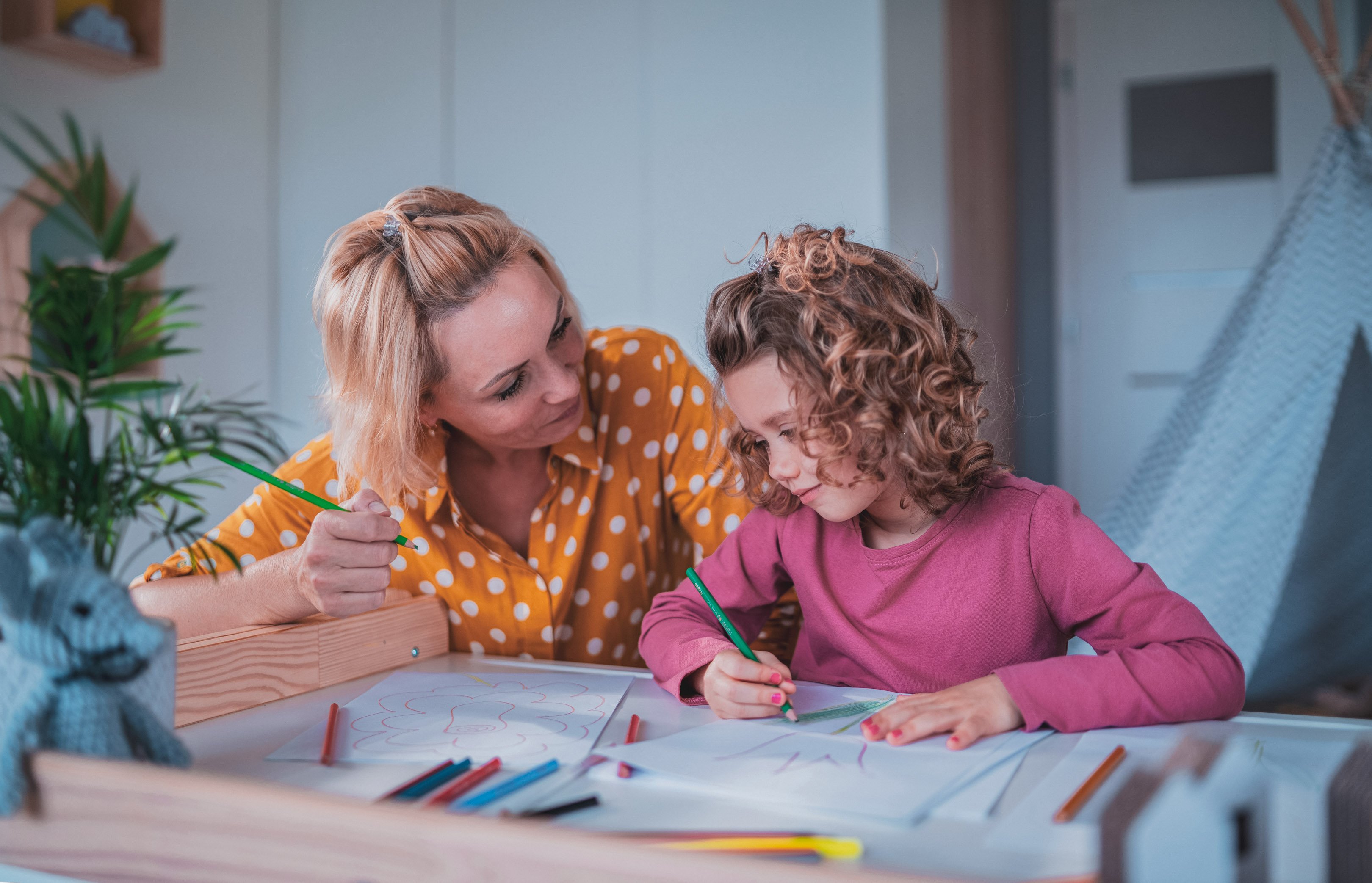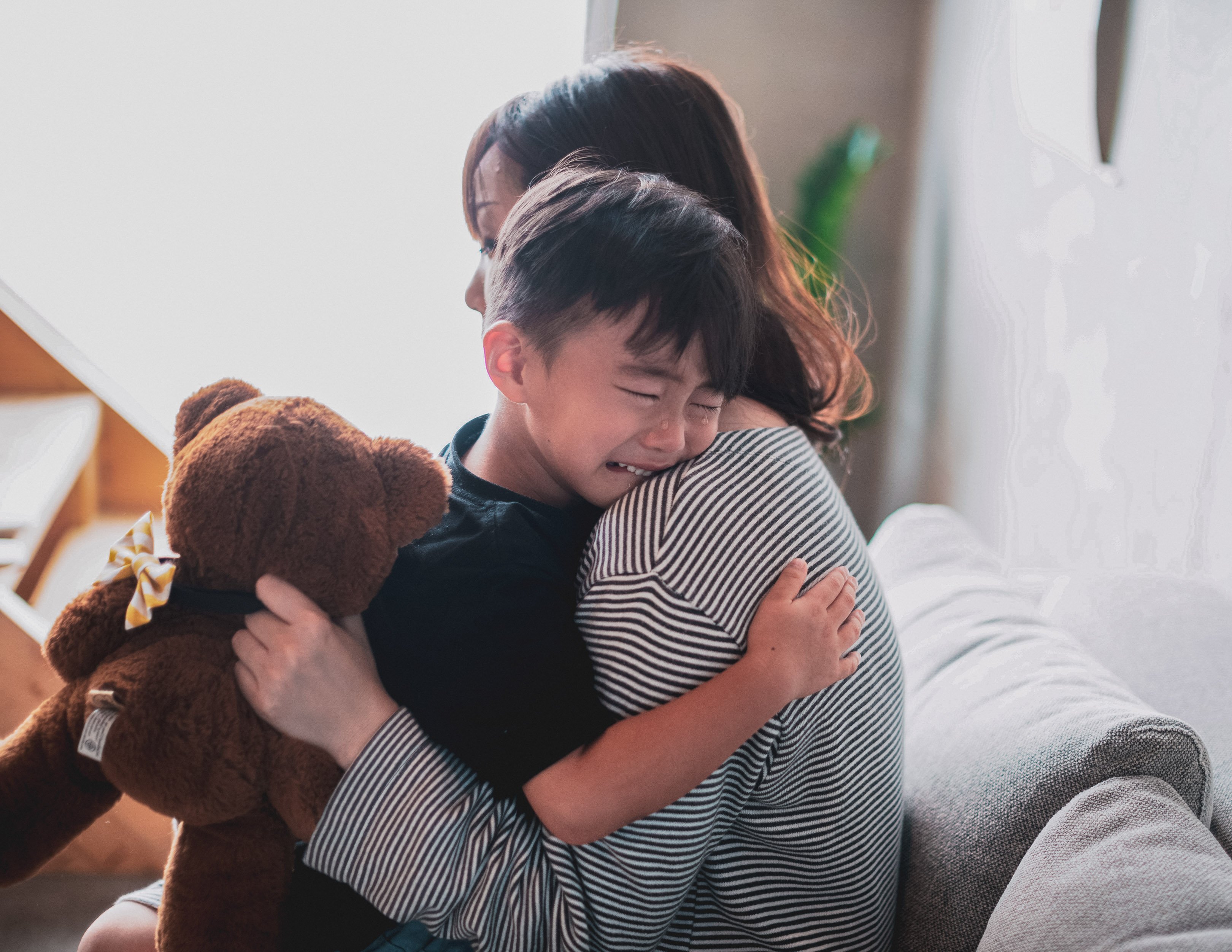How to Help a Child Cope With Grief: A Compassionate Parent’s Guide
Discover compassionate ways to help children grieve. Learn how to talk about loss, maintain routines, and nurture healing for every age group.



Grief affects everyone, including kids. But unlike adults, children often don’t have the words or emotional tools to explain what they’re feeling. Their grief may appear as silence, questions, or changes in behavior, which is difficult for parents to witness while navigating their own loss.
You can’t take their pain away, but you can help them through it by offering comfort, honesty, and stability as they learn to process emotions and grow after loss.
This guide explains how grief looks at different ages, offers practical ideas for helping a child cope with grief, and explains when to seek extra help so your child feels safe, understood, and supported.
Key takeaways:
- Grief is a natural response to loss, but children cope differently and may not show emotion the way adults do.
- How a child understands death depends on age, emotional development, and the nature of the loss. Children understand more as they grow.
- Parents and caregivers play a crucial role in helping children cope by offering reassurance, structure, and a safe space to talk and express grief.
Understanding childhood grief

Grief is a normal response to loss. For children, this often follows the death of a parent or another loved one but can also arise from major changes, like moving homes or parental separation. It’s the process of adapting to life without someone or something important in the child’s life.
Children are sometimes called “invisible” grievers because their pain isn’t always obvious. They may seem fine, but still feel grief deeply. How they express it depends on their age, closeness to the person, and the circumstances of the loss.
Grief may show up as:
- Physical symptoms such as fatigue, headaches, and stomachaches
- Emotional symptoms like sadness, anger, guilt, anxiety, and intense emotional pain
- Cognitive symptoms like confusion, trouble focusing, and forgetfulness
Children grieve in cycles. Feelings may come and go over time, resurfacing as they grow and understand the loss in new ways, especially around birthdays or anniversaries. Very young children may also “puddle-jump” between grief and play, moving in and out of sadness to protect themselves from being overwhelmed.
Repeated questions like “When is Grandma coming back?” or statements such as “My brother died” may seem odd to adults, but are normal ways children process loss and express their feelings.
The three C’s of grief
When children experience loss, they often wrestle with confusion, guilt, and unanswered questions. Beneath these feelings, three common fears, known as the “three C’s” of child grief, tend to surface.
1. Cause: Did I cause it?
Most young children are especially prone to magical thinking, believing their thoughts, wishes, or actions can cause events to happen.
Reassure them gently: “Nothing you said, did, or thought caused this. Grandma’s illness made her body stop working.” At the same time, tell them that nothing they do can change what happened, using clear, simple language.
Encourage questions and be honest. Knowing the truth helps replace guilt with understanding and allows children to start healing.
2. Cure: Can you cure it?
Children may worry that death is contagious, especially if illness was involved. School-age children understand illness differently, so explaining that death isn’t something you can “catch” helps.
Addressing this fear directly helps restore a child’s sense of safety and control and reassures children that adults will keep them safe.
3. Care: Who will care for me?
A major loss can leave children wondering who will look after them, particularly if their primary caregiver has died. This uncertainty can heighten anxiety and make it hard for them to feel secure.
Provide clear, consistent reassurance about who will take care of them, again and again if needed. Keeping routines steady, involving family members, and explaining any changes step-by-step helps rebuild trust and stability.

Encourage emotional expression
Children need safe, age-appropriate ways to express the complex emotions that come with loss. Creative outlets like art, play, or writing can turn big feelings into something tangible and manageable, helping children develop healthy coping skills.
These activities relieve stress but also bring a sense of accomplishment, lifting mood, fostering positive emotions, and easing the weight of sadness or anxiety in healthy ways.
Drawing and painting
Art lets children express what they can’t yet say in words. Art provides an avenue for the child to work through their sadness, anger, fear, and confusion, remember the person who died, and slowly rebuild a sense of meaning after the loss.
Creating something with crayons, paint, or clay gives them a sense of control and helps organize overwhelming emotions. Encourage creativity by providing simple materials and offering gentle prompts, such as, “Can you draw a happy memory with Grandma?”
Whether or not they share the story behind it, the act of creating itself offers comfort and healing and helps the child express emotions.
Memory box or scrapbook
Keeping memories alive helps children make sense of loss. Creating a memory box or scrapbook reassures them that remembering and talking about their loved one is okay.
Invite your child to decorate a box or journal with photos, notes, or keepsakes. Talk about each item and what it represents. Make it a family project so every family member can contribute. Prompts like “What’s your first memory of your loved one?” or “What was their best quality?” can gently encourage sharing and reflection.
Keep these items somewhere the child can revisit at any time. Turning it into a family project, where everyone contributes memories, reinforces that love and connection endure even after loss and supports the grieving process.
Storytelling and role play
Children often process difficult experiences through play. Pretend scenarios and storytelling create emotional distance, making it easier to express feelings and explore them safely. Telling stories with dolls, puppets, or drawings can help a grieving child narrate what happened and what helps.
A 2023 study found that storytelling-based approaches to grief help children process complex emotions in age-appropriate ways, express unresolved feelings, and find hope by imagining positive possibilities for the future.
Role plays let children direct the story, which can be empowering when real life feels out of control. In these make-believe scenarios, children may reenact the loss or explore different “what-ifs.”
Encourage your child to act out stories with dolls or puppets, or make up new ones. They might revisit the loss or imagine comforting endings. This kind of play allows the child to confront difficult realities in a gentle, supported manner and find meaning in the experience they were previously unable to process.
Open and honest conversations about death
While creative outlets help, children also need truthful, age-appropriate conversations about death. Avoid euphemisms like “went to sleep,” which can confuse or frighten them. Use clear, concrete language to explain death: “Grandpa died. His body stopped working.”
Be open to questions and repeat explanations when needed. Honesty builds trust and helps them feel safe asking about what’s on their mind. Good children’s books about grief can also open gentle, meaningful dialogue and support children who find it hard to talk about their grief.

Tips to help children cope by age group
It’s important to understand that kids grieve differently and that support should match a grieving child’s needs. Understanding how children perceive death helps you respond in ways that feel safe and supportive, protecting them from confusion.
Infants and toddlers
Babies and toddlers have no concept of death, but they sense changes in their environment, routines, or shifts in the emotional climate.
Behavior:
- Fussiness, inconsolable crying
- Clinginess or withdrawal
- Changes in sleep or feeding routines
- Loss of interest in toys or play
What to do:
- Keep routines and other family members caring for them as consistent as possible
- Provide frequent physical comfort, affection, and soothing
- Maintain a calm environment and offer gentle reassurance for very young children
Preschoolers (3 to 5 years)
Preschoolers may use the word “dead” but see death as reversible or temporary, thinking the person can come back or be “fixed.”
Behavior:
- Acting unaffected or “clowning around”
- Regressive behaviors (thumb sucking, baby talk)
- Repeated questions about the death
- Nightmares or sleep problems
- Separation anxiety
- Expressing emotions through play
What to do:
- Use clear, simple, and concrete words (“dead,” “died”)
- Avoid vague terms (“gone away,” “sleeping”)
- Patiently repeat explanations as needed
- Reassure them that they did not cause the death
- Provide affection, security, and opportunities for play and talk
- Include them in family rituals and explain what to expect
- Use storybooks to help them understand, especially for younger children
School-aged children (6 to 9 years)
Children start to grasp that death is permanent and irreversible, though many still believe it happens only to others, older people, or “bad” people.
Magical thinking may lead them to believe their thoughts or behaviors caused the death. They may also personify death (e.g., a ghost or the Grim Reaper). School-age children may benefit when school administration and teachers know what’s happening.
Behavior:
- Guilt or self-blame (“It’s my fault”)
- Anxiety about the safety or health of loved ones
- Regressive behaviors
- Aggressive or withdrawn behavior
- Trouble concentrating or in school
- Curiosity about what happens after death
What to do:
- Encourage honest questions and answer factually
- Reassure them that death wasn’t their fault
- Maintain structure and normal routines
- Offer outlets for expression (drawing, writing, memory-making activities)
- Model healthy emotional expression
- Include them in family rituals and memory activities; elementary school children often find structure soothing
Pre-teen (9 to 12 years)
Pre-teens understand death as final and universal. They may begin to think about their own death and become curious about what happens after death. Some may question religious beliefs or fear losing more loved ones.
Behavior:
- Withdrawal or avoidance of emotional discussions
- Moodiness or anger toward caregivers
- Trouble at school or loss of interest in usual activities
- Sleep disturbances or somatic complaints
- Guilt or resentment
What to do:
- Be honest about what happened
- Provide time and space for discussion while respecting privacy
- Encourage participation in memorials or rituals
- Maintain routines and encourage healthy ways to express emotion
- Model open, balanced grieving and self-care
Teens (13 to 18)
Adolescents have a mature understanding of death’s finality but may question spiritual beliefs, their own life’s meaning, and life's fairness. Grief can clash with the need for independence and peer belonging, making it difficult to ask for help.
Behavior:
- Withdrawal or isolation
- Anger, guilt, or “life is unfair” attitudes
- Risk-taking or acting out (e.g., reckless driving, substance use)
- Academic decline or apathy (“what’s the point?”)
- A preference to talk with peers rather than adults
What to do:
- Offer emotional availability but respect privacy
- Encourage healthy outlets, such as sports, journaling, music, or art
- Invite them to share memories or participate in rituals if they wish
- Reinforce normal limits and routines to promote safety
- Model vulnerability by expressing your own feelings appropriately
- Connect them with peers or grief support groups for bereaved children
Maintain routines and security
Grief can make a child’s world feel unpredictable or unsafe. Routines bring comfort by showing that life continues, even if it looks different now. Keep daily structures like meals, bedtimes, and school as steady as possible while remaining flexible when your child needs extra comfort or rest. This helps support children during such an intense experience.
It’s also important to uphold household rules and expectations. Grieving children may test limits or regress as they cope, but consistency in boundaries helps them feel safe. Keeping familiar rules signals that the adults are steady and in control, which reassures a child afraid of more change and helps with helping children deal with loss.

Model healthy grieving
Children learn to grieve by watching the adults around them. Children’s emotional responses to loss are shaped largely by how adults around them react.
Showing a range of emotions and talking about loss openly teaches that grief is normal and that feelings can be shared safely.
You might say, “I feel sad that Grandma died. I miss her too. It’s okay to feel sad together.” Demonstrating calm honesty (not hiding emotions, but not being overwhelmed by them) helps children learn that pain softens with time and that there’s no right or wrong way to grieve.
You can also model healthy ways of coping in simple, everyday ways:
- Taking walks or exercising
- Writing or drawing memories
- Seeking support from a mental health professional
- Looking at photos or telling stories
- Taking care of yourself with rest and nourishment
Modeling grief doesn’t mean sharing every adult worry; it means showing that strength and sadness can coexist, and that healthy coping skills can grow with practice.
Provide additional support and professional help

It’s normal for children to feel grief and have intense reactions weeks following the death of their loved ones. However, up to 10% of grieving children develop prolonged grief reactions.
The persistence of one or more of these signs may indicate that your child may need professional help:
- Extreme mood swings or persistent sadness
- Withdrawal from friends or activities
- Drop in school performance
- Sleep or appetite changes
- Self-blame, fear of being alone, or talk of wanting to “join” the person who has died
If these signs persist, reach out for professional support. Many resources can help your child process grief in a healthy way, including school psychologists, a child’s doctor, school counselors, child therapists, or grief support programs.
A trusted mental health clinic or mental health professional can guide next steps. Virtual options like Emora Health can also bridge gaps in care, offering convenience, privacy, and a safe space to talk, especially when in-person support isn’t possible.
How Emora Health can help
Grief can be overwhelming — not just for children, but for parents and caregivers trying to stay strong while helping their child cope. It’s hard to know what to say or how to make things feel okay again. Emora Health can help.
Our licensed therapists specialize in supporting children and families through grief and loss. Using evidence-based approaches like play, art, and family therapy, they help kids express their feelings when words are hard. Trauma-focused cognitive behavioral therapy (TF-CBT) helps children process loss, build healthy coping skills, and manage big emotions in healthy ways.
Every family’s experience with grief is different. Emora therapists tailor care to each child’s needs, guiding you with tools to communicate, nurture resilience, and heal together.
Frequently Asked Questions
It really depends on their age and emotional development. Many children grieve in short bursts. It’s their way of protecting themselves from being overwhelmed. Grief is also cyclical. As children develop, they often revisit their loss with new questions or feelings.
Some kids might show it through behavior changes or even physical symptoms like tummy aches, especially when they can’t put big emotions into words. Children grieve differently, and that’s okay.
They represent children’s common fears after loss:
- Cause: Did I cause it?
- Catch: Can I catch it?
- Care: Who will care for me?
Above all, they need love, honesty, and safety. Keeping routines, offering affection, and using clear language help them feel secure. Include them in rituals, express feelings together, and use grief support resources when needed to support children through the grieving process.
- Chachar, A. S., Younus, S., & Ali, W. (2021). Developmental understanding of death and grief among children during COVID-19 Pandemic: Application of Bronfenbrenner’s Bioecological model. Frontiers in Psychiatry, 12, 654584. https://doi.org/10.3389/fpsyt.2021.654584
- Chandran S, Raman V, Shiva L. Understanding Grief in Children: A Narrative Review. Journal of Indian Association for Child and Adolescent Mental Health. 2025;21(2):122-129. https://doi:10.1177/09731342251328150
- De Andrade, M. L., Mishima-Gomes, F. K. T., & Barbieri, V. (2018). Children’s grief and creativity: the experience of losing a sibling. Psico-USF, 23(1), 25–36. https://doi.org/10.1590/1413-82712018230103
- Green, D., Karafa, K., & Wilson, S. (2020). Art Therapy With Grieving Children: Effect on Affect in the Dual-Process Model. Art Therapy, 38(4), 211–215. https://doi.org/10.1080/07421656.2020.1823197
- Grief and children. (September 2023). American Academy of Child and Adolescent Psychiatry. https://www.aacap.org/AACAP/Families_and_Youth/Facts_for_Families/FFF-Guide/Children-And-Grief-008.aspx
- Hill, K. E., & Lineweaver, T. T. (2016). Improving the Short-Term Effect of Grieving Children Through Art. Art Therapy, 33(2), 91–98. https://doi.org/10.1080/07421656.2016.1166414
- Institute of Medicine (US) Committee for the Study of Health Consequences of the Stress of Bereavement; Osterweis M, Solomon F, Green M, editors. Bereavement: Reactions, Consequences, and Care. Washington (DC): National Academies Press (US); 1984. CHAPTER 5, Bereavement During Childhood and Adolescence. Available from: https://www.ncbi.nlm.nih.gov/books/NBK217849/
- Koukourikos, K., Tsaloglidou, A., Tzeha, L., Iliadis, C., Frantzana, A., Katsimbeli, A., & Kourkouta, L. (2021). An Overview of Play Therapy. Materia socio-medica, 33(4), 293–297. https://doi.org/10.5455/msm.2021.33.293-297
- Melhem, N. M., Porta, G., Walker Payne, M., & Brent, D. A. (2013). Identifying prolonged grief reactions in children: dimensional and diagnostic approaches. Journal of the American Academy of Child and Adolescent Psychiatry, 52(6), 599–607.e7. https://doi.org/10.1016/j.jaac.2013.02.015
- Mukba, G., & Akbaş, T. (2023). Examination of children’s grief experiences through storytelling-based systemic intervention: Case study. Children and Youth Services Review, 152, 107078. https://doi.org/10.1016/j.childyouth.2023.107078
- Safarifard, R., Kiernan, G., Corcoran, Y., Courtney, E., Mitchell, J., Akard, T., & Lambert, V. (2024). Memory-making interventions for children and their families receiving pediatric palliative or bereavement care: A systematic review protocol. HRB open research, 7, 30. https://doi.org/10.12688/hrbopenres.13891.2
- Schonfeld, D. J., Demaria, T., Nasir, A., Kumar, S., Nasir, A., Berger-Jenkins, E., Johnson, T., Dworkin, P., Davis, B. E., Sriraman, N., Schlesinger, A., Stancin, T., Fraser, H., Davis, K. H., DeBattista, A., Warczak, Z., Wheatley, R. R., Krug, S. E., Chung, S., . . . Glasstetter, E. (2024). Supporting the grieving Child and Family: clinical report. PEDIATRICS, 154(1). https://doi.org/10.1542/peds.2024-067212
